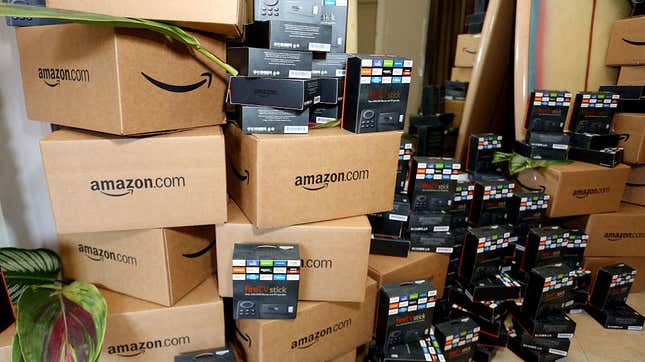Cheap Baby Toys Sold on Amazon Might Be Dangerous Counterfeits
Latest

Once every couple of months, I use Amazon to buy a giant jar of snail snot that I rub on my face as a talisman against aging. The packaging is covered in mostly Korean writing, and literally anything could be in the jar (but what could possibly be grosser than snail mucus?). I am an adult and understand the foolishness of my actions, and if I burn my face off with counterfeit gastropod jizz, that’s my own business. However, a bunch of counterfeit children’s toys being sold on Amazon are potentially deadly, and the company, predictably, doesn’t seem to care all that much.
Inc. recently published a piece that explained how shoddily made and potentially lethal children’s toys end up on Amazon. For example, those little pacifiers that gave babies hilarious mustaches a few years ago, Mustachifiers, became an Amazon best-seller, leading to an influx of knockoffs that caused choking, according to Jason Feinberg, whose company sold the original Mustachifier:
“Sometime that year, Feinberg started getting emails from Amazon buyers complaining that their Mustachifiers were defective. A verified buyer posted a review showing a pacifier whose bulb had completely separated from the shield. A mother named Doreen wrote Feinberg to say she’d given her son a Mustachifier and set him in his play pen while she prepared food. “All of a sudden, he started coughing,” she wrote. ‘When I arrived it turns out his pacifier broke in two pieces and he had almost swallowed the rubber nipple. I was able to take it out of his mouth [in] time!’”
Feinberg quickly realized that the pacifiers falsely claiming to be Mustachifiers were actually cheap counterfeits. In the U.S., children’s products are stringently regulated by the Consumer Product Safety Improvement Act (CPSIA), which imposes strict testing and labeling requirements on products for children under 12. However, Amazon sellers who use the third-party Seller Central or Marketplace platforms aren’t required to prove CPSIA certification. The company simply says that “Sellers are responsible for tracking and complying with any regulations issued by the CPSC.”
This, of course, provides the perfect environment for unethical businesses to sell knockoffs using stolen images and product descriptions from competitors’ pages. At a glance the copycat products seem just as legit as the originals, leaving consumers, who probably assume Amazon wouldn’t let sellers kill children, with identical-seeming options.
There’s at least one instance of a counterfeit Amazon product proving harmful. In December 2018, a four-year-old in Wisconsin swallowed 13 magnets from a shoddy counterfeit toy that broke open. He had to have parts of his colon and intestines removed.
And while the company seems to have become a bit more responsive since the Wisconsin incident, business owners like Feinberg say that Amazon has been slow to take any meaningful action. Frustrated by the lack of support he had from the company to get counterfeit Mustacifiers off the site, Feinberg even wrote to Jeff Bezos, who’s known to monitor his own inbox:
“Sooner or later a baby is going to choke on one of these if they continue to be distributed, which is why I’m stepping forward to try to resolve this, even if doing so may be detrimental to my own business,” Feinberg wrote.
No one ever followed up.